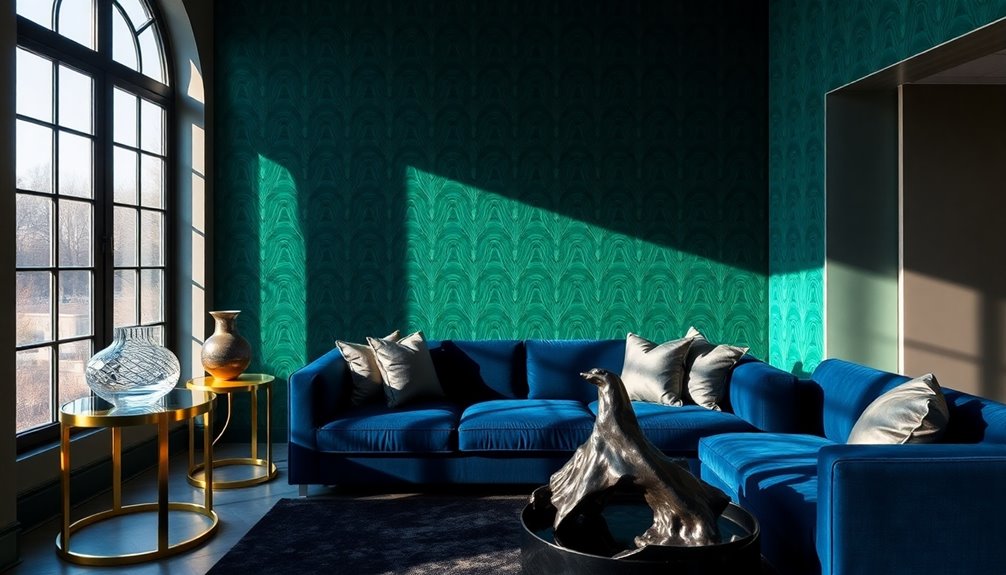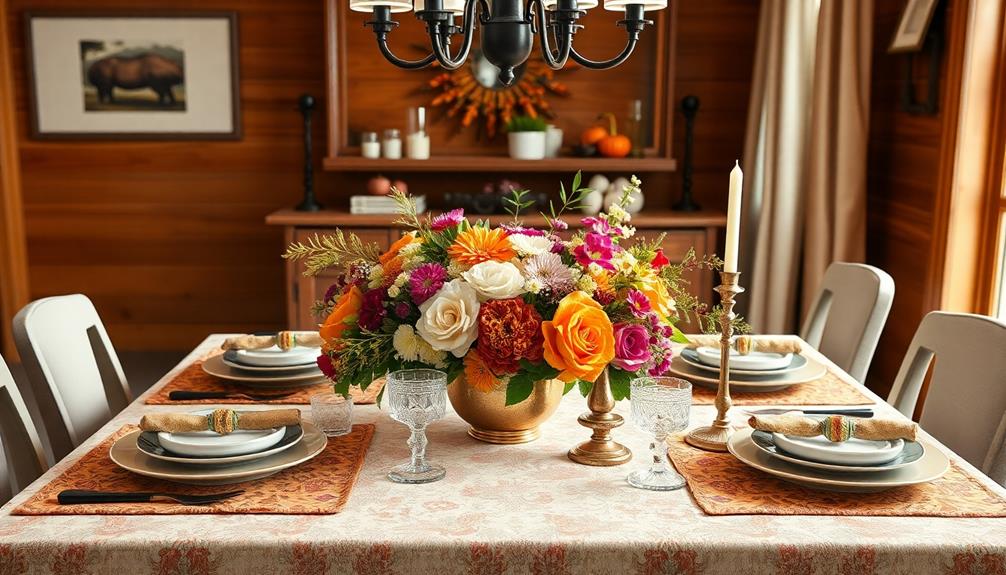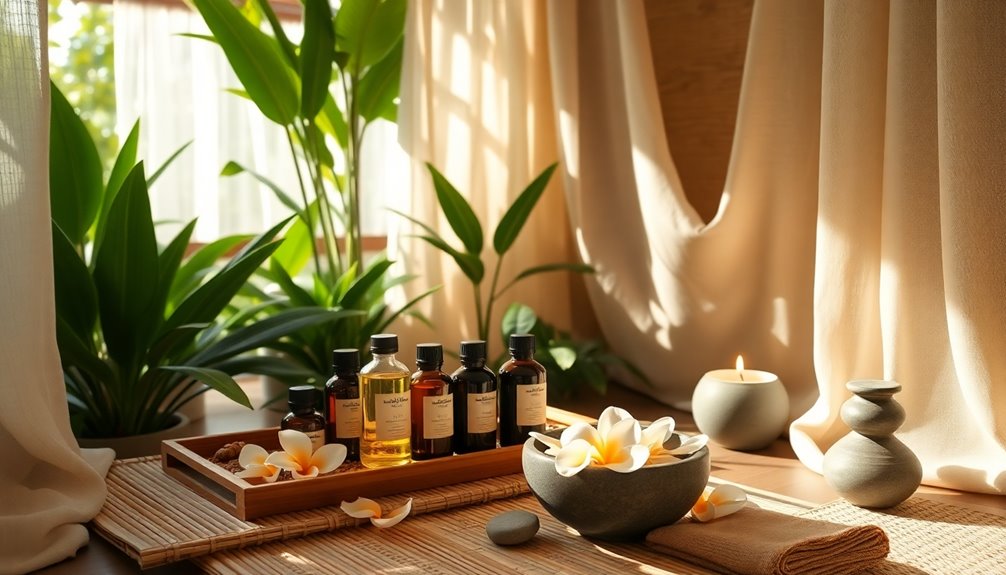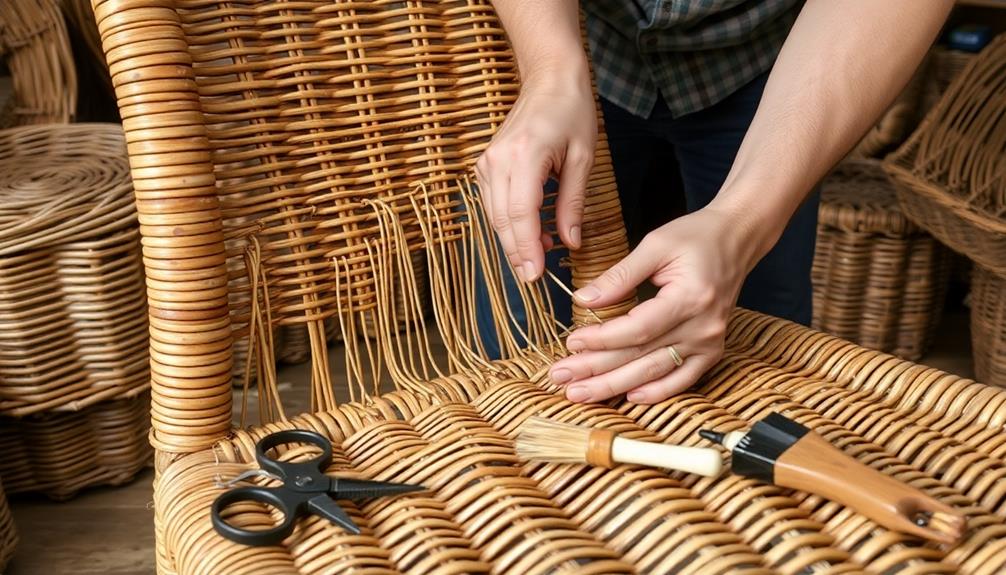You can transform your small space into a stylish Art Deco retreat with smart choices and a keen eye for design. Start by selecting multi-functional furniture that fits well without crowding. Embrace bold geometric patterns and a limited color palette to maintain sophistication. Use mirrors and metallic accents to enhance light and create an illusion of spaciousness. Add luxurious textures through plush rugs and rich fabrics. Don't forget strategic lighting to highlight focal points and create a captivating atmosphere. By incorporating these elements, you'll elevate your minimal square footage into a glamorous showcase of style. There's plenty more to explore!
Key Takeaways
- Choose multi-functional furniture to save space and enhance utility without compromising on the Art Deco aesthetic.
- Embrace bold geometric patterns and a limited color palette to create visual interest without overwhelming the small space.
- Utilize vertical space with shelves and wall-mounted decor to draw the eye upward and create the illusion of a larger area.
- Incorporate reflective surfaces, such as mirrors and metallic finishes, to amplify light and enhance openness in the decor.
- Define zones within the space using area rugs or lighting to create distinct areas while maintaining a cohesive Art Deco theme.
Understanding Art Deco Elements
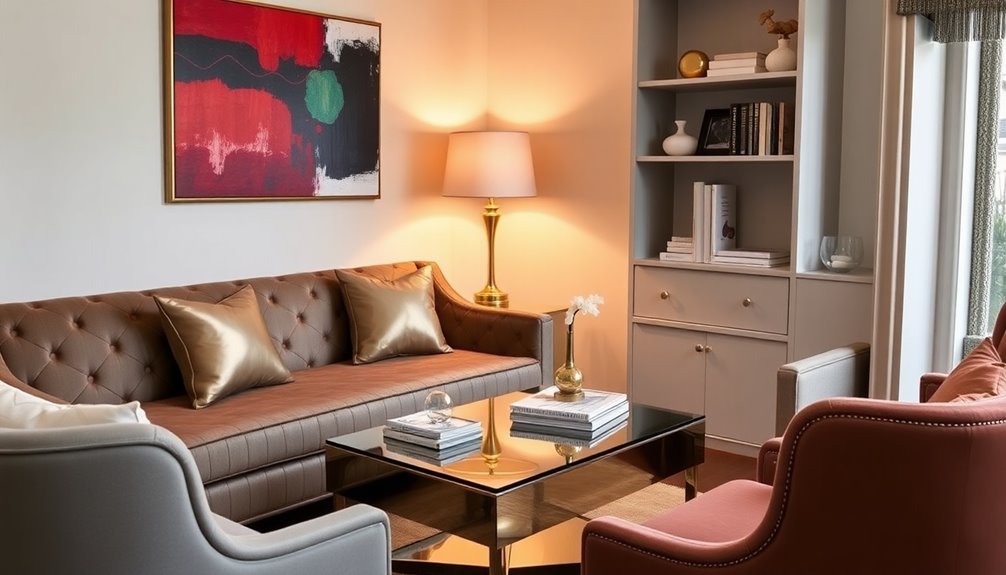
Art Deco is defined by several key elements that create its distinctive aesthetic. You'll notice the bold use of geometric shapes and patterns, including triangles, circles, squares, and rectangles. These shapes often form dramatic patterns, incorporating chevrons and stylized sunbursts that convey order and precision.
Symmetry plays a crucial role, with facades and interiors featuring balanced proportions and harmonious compositions that enhance visual appeal. This emphasis on balanced proportions is a hallmark of Art Deco architecture, contributing to its overall elegance and charm. The importance of energy-efficient technology in modern design can also enhance the sustainability of Art Deco-inspired spaces.
As you explore Art Deco, pay attention to the luxurious materials used. Designers often combine exotic materials like ebony and marble with modern substances like stainless steel and glass. This blend underscores the opulence characteristic of the era.
Ornate decorative elements, such as intricate carvings and bas-reliefs, add sophistication and depth to the overall design.
In your own space, you can incorporate these elements through geometric patterns in textiles or wall art, and luxurious finishes on furniture. Look for symmetrical arrangements that create visual balance, and don't shy away from using rich materials to enhance the ambiance.
Choosing Scaled Furniture
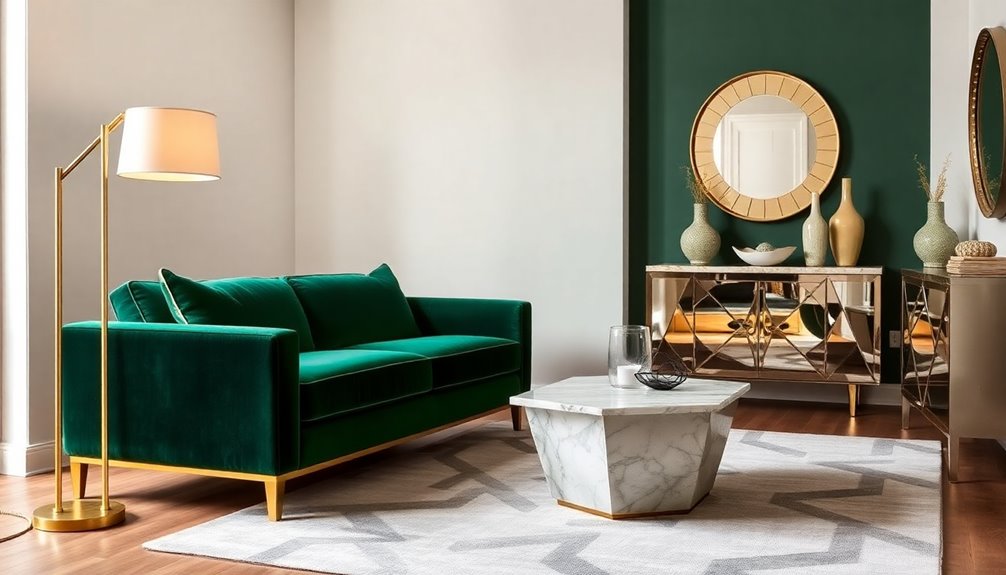
To effectively bring the luxurious elements of Art Deco into your small space, choosing scaled furniture is key. Start by measuring your room and the furniture you want to include. This ensures everything fits well without overwhelming the area. A helpful trick is to use painter's tape to mark out potential furniture sizes on the floor. This visual aid gives you a clearer picture of how pieces will interact within the space.
Opt for multi-functional furniture that serves more than one purpose; this can help maintain a clean, uncluttered look. While larger pieces can work in small areas, select items with simple shapes that don't crowd the room. Each piece should have a meaningful role, enhancing both utility and aesthetics. Incorporating geometric shapes into your furniture choice not only aligns with the Art Deco aesthetic but also adds visual interest without overwhelming the space. Additionally, consider the importance of budgeting when selecting furniture to ensure you make wise financial decisions while enhancing your home.
Pay attention to the height of your furniture, especially in rooms with low or slanted ceilings. Balance your furniture with equally scaled artwork and rugs to create a cohesive look.
Avoid common mistakes, like using too-small rugs or dinky artwork, which can make the space feel fragmented. By carefully selecting and scaling your furniture, you can maximize style while maintaining functionality in your Art Deco-inspired small space.
Strategic Furniture Arrangement
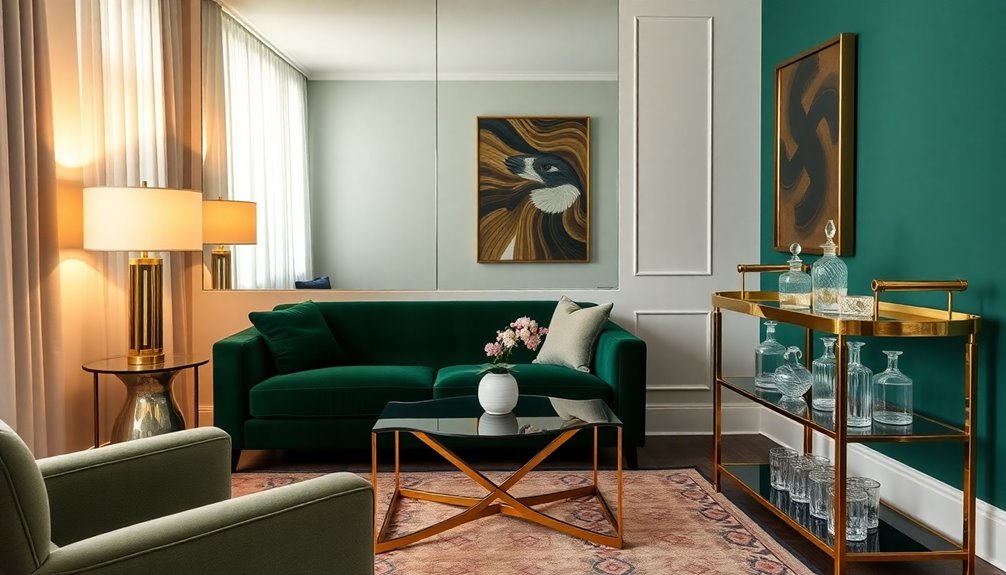
Effective furniture arrangement can transform your small space into a stylish and functional oasis. Start by placing your furniture against the walls, which maximizes floor space and creates a visually expansive area. Arrange sofas and tables to hug the room's perimeters, allowing for a clearer path through the space and reducing clutter. This strategy enhances your overall sense of openness.
Next, consider incorporating multi-functional furniture. Items like storage beds and foldable bedside tables serve more than one purpose, helping you reduce the number of pieces in your room. These versatile items increase your storage capacity without adding bulk, keeping your space neat and organized. Incorporating geometric designs in your furniture choices can further enhance the Art Deco aesthetic while maintaining functionality. Additionally, adding plants for improved air quality can create a refreshing atmosphere in your small space.
Creating a continuous flow is also key. If possible, remove partition walls to link different areas of your home, ensuring smooth transitions between living, cooking, and sleeping spaces. This interconnectedness makes your area feel larger and more inviting.
Simplifying Color Choices
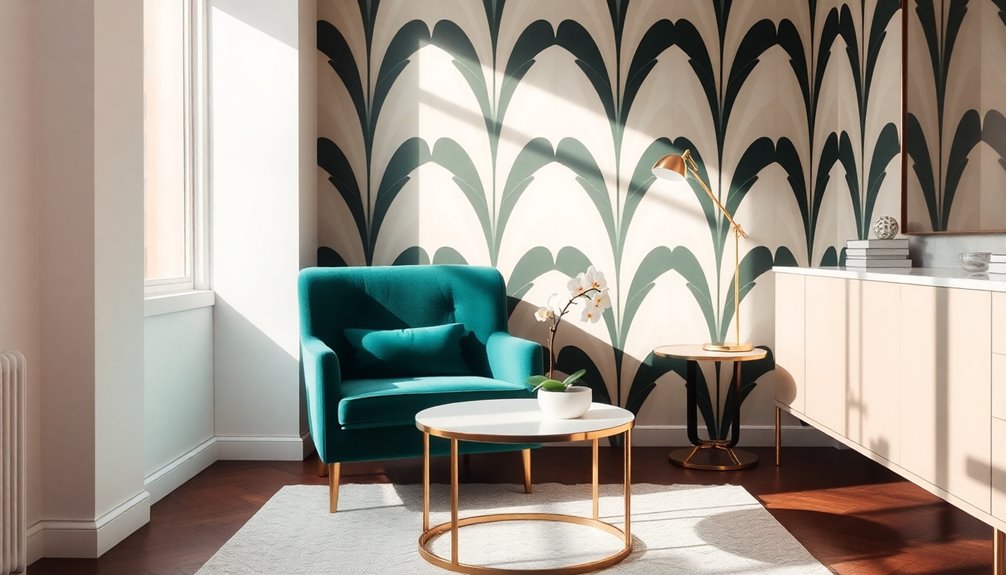
While navigating the challenges of a small space, simplifying your color choices can significantly enhance the overall aesthetic. Start by limiting your palette to one or two key hues. Opt for a classic combination, like black and white or cream and gold, to maintain simplicity and sophistication.
Avoid eclectic color mixes; they can overwhelm your design and disrupt the cohesive feel of your space.
Incorporate metallic finishes like chrome, gold, and brass to amplify the sense of openness. These reflective elements catch and bounce light, making your room feel larger and more luminous.
Consider using chrome-framed mirrors or gold-accented furniture to add that extra touch of elegance. Brass complements green for a classy look, enhancing both sophistication and visual appeal.
Art Deco color combinations can also play a vital role. Think about soft blues paired with neutrals or classic pinks and greens alongside gold accents.
Balancing bold hues with neutral tones is essential too; deep blues or forest greens can be beautifully offset by lighter shades like cream or beige.
Incorporating Bold Patterns
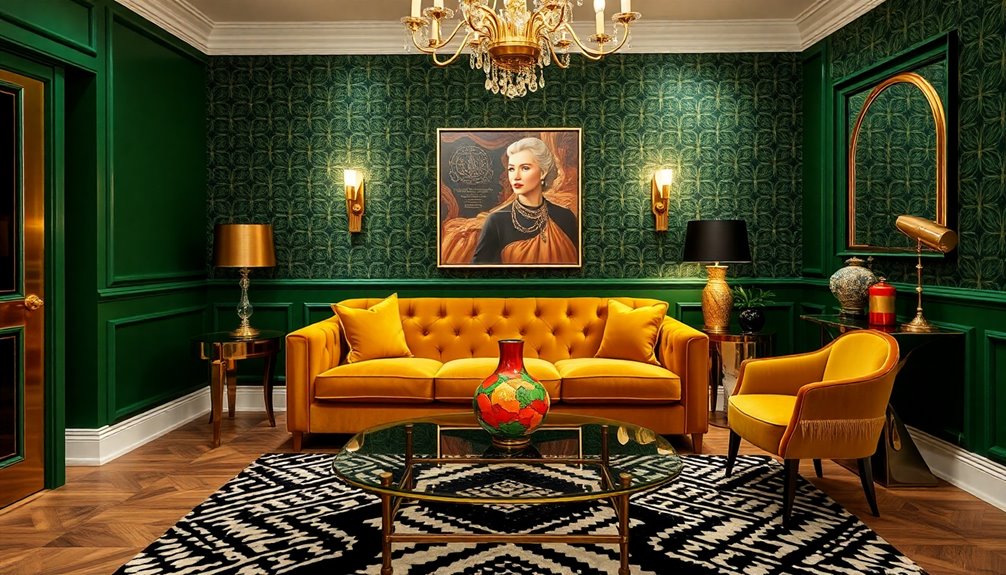
Incorporating bold geometric patterns can transform your small space into a striking visual experience. Use triangles, chevrons, and zigzags to introduce drama and interest. By ensuring symmetrical placement, you maintain balance and elegance, preventing the space from feeling chaotic.
Consider integrating geometric patterns through various textiles—think wallpaper, area rugs, and upholstery. A mural of triangles on a wall can serve as a focal point, giving your room a structured design. Additionally, effective preparation for selecting these patterns can enhance your overall design strategy.
Don't shy away from mixing in different shapes like squares and circles to enrich your space further. When it comes to furniture, opt for patterned upholstery to elevate glamour and sophistication. Bold geometric shapes are an essential element often seen in wallpapers, textiles, and decor, amplifying the overall design impact.
Accent pieces such as vases or decorative panels can enhance the design without overwhelming the space. Apply geometric motifs to both walls and flooring to create a cohesive environment.
Keep in mind that a clutter-free design allows patterns to shine. Use neutral backgrounds to let bold patterns stand out, and arrange patterned pieces symmetrically for a polished look.
Focus on quality over quantity to avoid visual overload, allowing your chosen geometric patterns to take center stage.
Statement Lighting Ideas
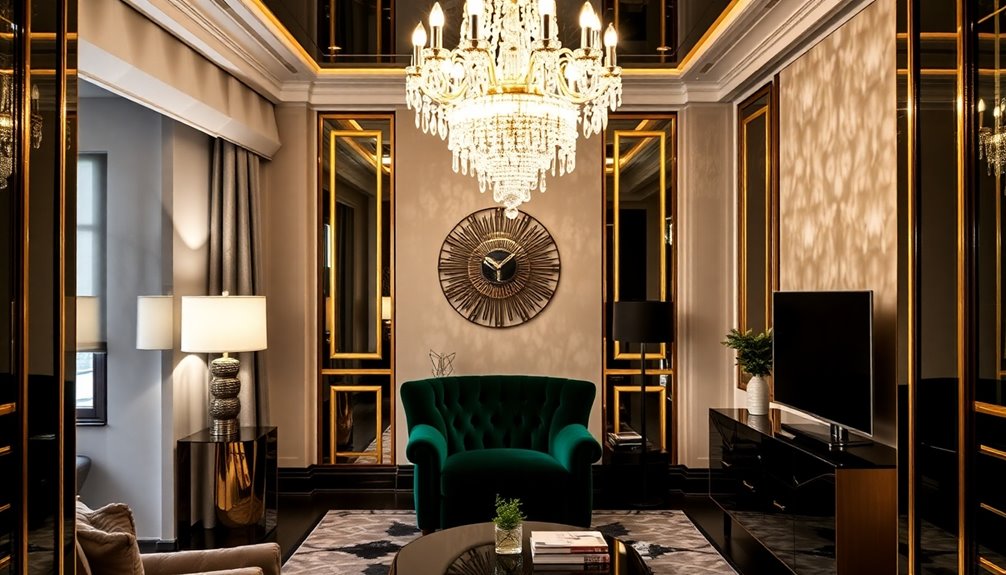
When it comes to defining your small space with Art Deco flair, statement lighting plays a crucial role. Opt for fixtures made from luxurious materials like ivory, bronze, or Murano glass. These elements not only add grandeur but also elevate your space's elegance.
Look for geometric shapes, zigzags, and chevrons in your lighting designs to maintain that signature Art Deco aesthetic. Additionally, many popular options in Art Deco lighting, such as the Sphere No. 3 Pendant, are designed to fit various budgets and styles.
Consider pendant lights in various sizes to fit different areas, from a grand foyer to your dining table. A striking chandelier can serve as an eye-catching focal point, while medium to large pendants can illuminate kitchens or dining spaces with style.
Ensure your fixtures have clean lines and captivating patterns that contribute to the overall drama of the room. Don't forget about modern compatibility—integrate smart bulbs with a warm glow to keep the vintage ambiance alive. You can even install fixtures that work with home automation systems, providing convenience without sacrificing style.
Ultimately, strategically placed statement lighting will create a captivating atmosphere and reflect the timeless charm of Art Deco in your small space.
Utilizing Reflective Surfaces
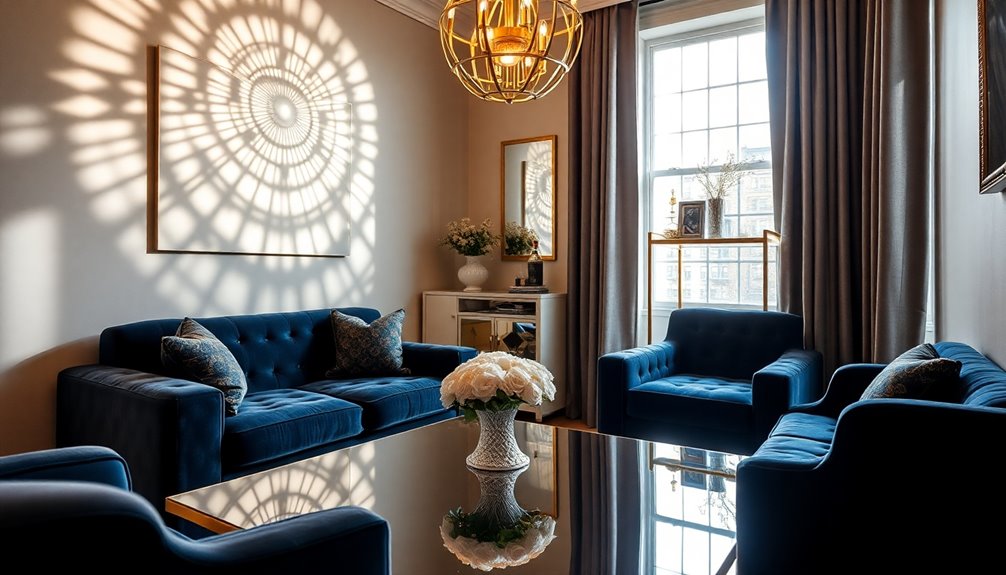
Reflective surfaces can dramatically transform your small space, creating the illusion of openness and light. By incorporating mirrors, you can enhance depth and luminosity in any room. Strategically placing large mirrors in living rooms or hallways not only reflects light but also makes these areas feel more expansive. Antiques can also serve as unique reflective elements that bring character to your space, adding to the overall charm.
Consider using mirrored furniture like consoles or dressers, which catch incoming light and add a visual spectacle. Sunburst mirrors, a classic Art Deco element, can introduce a burst of energy and radiance, instantly elevating your decor. Additionally, integrating bold geometric shapes in your decor can further enhance the Art Deco aesthetic and create a striking visual impact.
In addition to mirrors, explore reflective surfaces like glass tables, metallic finishes, and glossy paint. Accents in chrome or gold amplify the sense of space while polished wood or marble adds elegance. Streamlined furniture with metallic finishes maintains clean lines and a cohesive look. A well-designed interior can significantly increase property value and appeal, making reflective elements a worthwhile investment.
Position reflective elements to catch natural light or the glow from lamps, enhancing the overall brightness of the room. Incorporate Art Deco wall mirrors with bold geometric patterns in focal areas to enhance aesthetics.
With thoughtful placement, reflective surfaces can truly maximize style in your small space while creating an inviting atmosphere.
Textures for Small Spaces
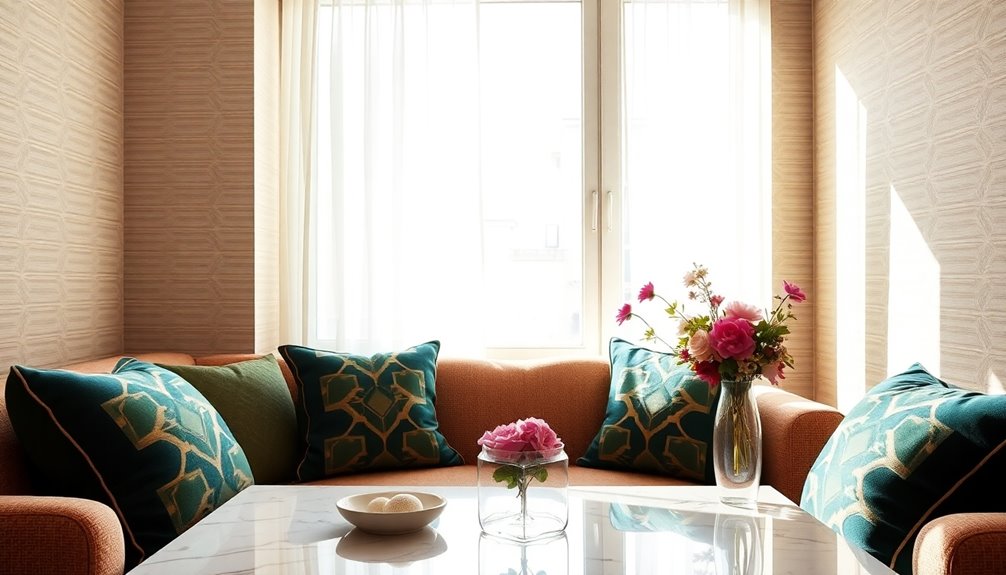
Textures play a crucial role in defining the character of small spaces, adding depth and interest without overwhelming the area.
Start by incorporating soft fabrics like plush rugs, fluffy cushions, or throws made of velvet and faux fur, which offer luxury and comfort. Natural elements, such as wood and stone, bring rustic charm and an earthy vibe. Additionally, using educational toys with varied textures can engage children's senses and promote tactile exploration.
For walls, consider textured coverings like shiplap or beadboard to create dimension without taking up floor space. Use patterned fabrics on curtains or upholstery to draw the eye and create movement. Additionally, the use of soft textures can evoke a sense of comfort and warmth, making a small room feel more inviting.
Mixing materials is key; pair rough textures like exposed brick with soft drapery for balance.
Layering textures enhances the sensory experience. Combine smooth furniture with rough or soft textures to add depth. A layered look can be achieved by stacking various fabrics and rugs.
Aim for visual interest through contrasts, ensuring that no single texture dominates the space.
Essential Decorative Accents
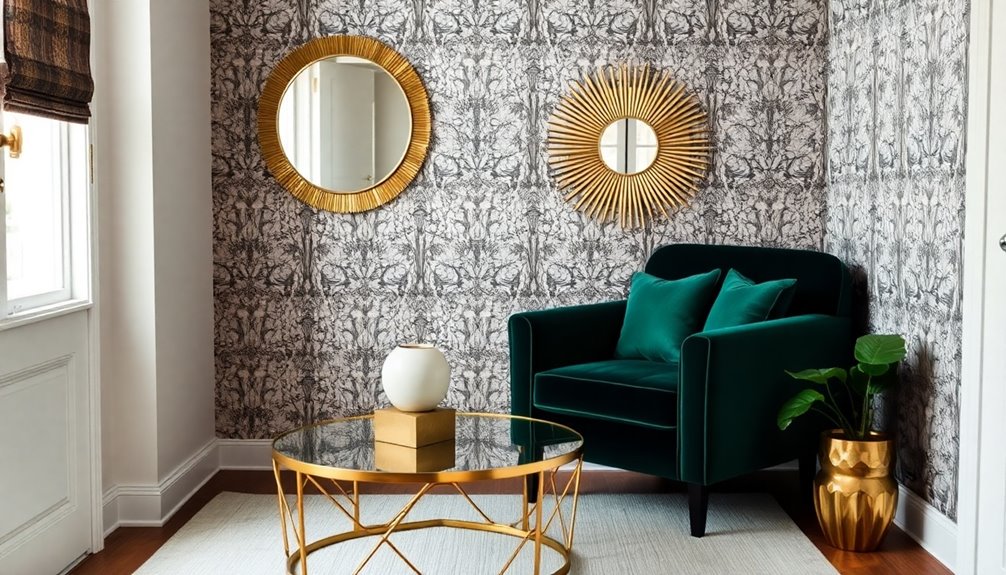
Decorative accents are vital in transforming small spaces into stunning showcases of Art Deco style. Start by incorporating mirrored surfaces; use mirrored furniture like consoles and dressers to create an illusion of depth and openness.
Strategically place chrome-framed mirrors to catch and reflect light, making your space feel larger and more dynamic. Mirrored furniture enhances visual appeal while reflecting light to make smaller spaces appear larger. Additionally, consider the use of energy-efficient models for any heated elements in your space to maintain comfort without excessive power consumption.
Opulent lighting fixtures can elevate your decor instantly. Install crystal chandeliers, sleek sconces, and geometric pendant lights to add glamour.
Choose fixtures made of glass and chrome to maintain a sophisticated look, and layer ambient and accent lighting for warmth. Tapered chrome lamp bases paired with simple shades offer a subtle tribute to Art Deco aesthetics.
Bold color palettes are another essential accent. Embrace jewel tones like emerald green or sapphire blue, balanced with neutral shades to maintain contrast.
Use bold geometrics in your fabrics and decor, incorporating graphic art with motifs like chevrons and sunbursts.
Creating a Glamorous Bar Area
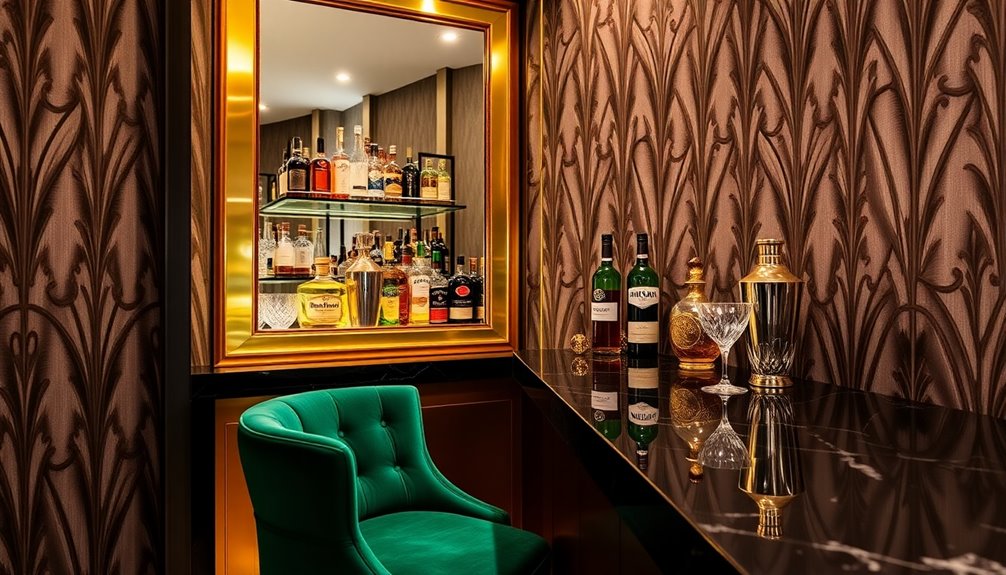
Transform your small space into a glamorous bar area that captures the essence of Art Deco style. Start by choosing compact bar cabinets or dry bars made of rich woods like mahogany or walnut. These pieces not only enhance functionality but also add a touch of elegance. Incorporate a vintage bar cart that serves as both storage and display for your essentials, allowing for flexibility in your setup. To further elevate the space, consider adding textiles like linen for a touch of softness and comfort.
Place your furniture against the walls to create a central area that feels grander. Incorporate geometric designs and metallic accents like chrome or brass to reflect light and elevate the space's sophistication. Aim for symmetry in your arrangement to maintain visual balance.
Effective lighting is crucial; use wall-washed fixtures or ornate chandeliers to highlight your bar area and its contents. Consider mirrored backings in your cabinets to amplify light and create an illusion of depth.
Choose a bold color palette featuring rich reds, blacks, and whites, complemented by luxurious materials like lacquer and marble. With these elements, your bar area will embody the glamour of Art Deco while maximizing your small space beautifully. To enhance the allure of your bar area, consider incorporating sleek geometric patterns and mirrored accents that reflect the bold color palette. Art Deco color schemes for interiors are all about making a statement, so don’t hesitate to add metallic details like gold or silver to elevate the opulence. Additionally, select stylish bar stools and lighting fixtures that echo the elegance of the era, creating a cohesive and inviting atmosphere.
Tips for Layering Accessories
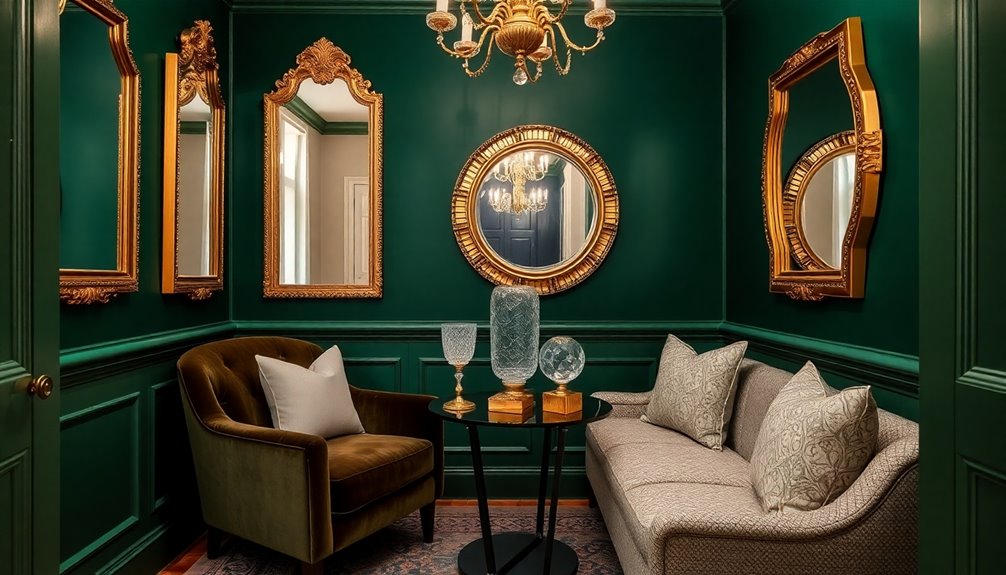
Layering accessories in your small space can elevate the Art Deco aesthetic and create a cohesive look. Start by incorporating metallic and reflective elements. Use chrome, gold, and mirrors to amplify light and create an illusion of space. Consider metallic finishes in your lighting fixtures, and opt for gold-accented chairs or chrome-framed mirrors to add sophistication.
Next, focus on geometric patterns and shapes. Select decor items like vases and light fixtures that feature bold, sharp geometric prints. This will add visual interest and make your space feel dynamic. You can also incorporate geometric designs in your wallpaper or rugs for an eye-catching statement.
Don't forget about textures and fabrics. Plush materials like velvet and silk will add a luxurious touch. Integrate ribbed or fluted textures in your decorative objects to enhance depth. Additionally, incorporating extravagant materials like marble can further elevate the overall design appeal.
Lastly, achieve symmetry for a balanced design. Arrange your furniture and decor items in harmonious ways, using matching sconces or twin pendant lights. Be mindful of your furniture scale to avoid overwhelming the space, and place larger items strategically to maximize your area.
Frequently Asked Questions
How Can I Add Art Deco Style Without Overwhelming My Space?
To add Art Deco style without overwhelming your space, choose bold geometric patterns, incorporate metallic accents, and embrace a limited color palette. Opt for streamlined furniture and multi-functional pieces to maintain elegance and openness.
What Are the Best Art Deco Colors for Small Spaces?
For small spaces, consider using a limited color palette with bold accents. Deep hues like emerald green or royal purple can create impact, while metallics and neutrals help balance and enhance the overall aesthetic.
Can I Mix Modern Furniture With Art Deco Decor?
Absolutely, you can mix modern furniture with Art Deco decor! Just balance clean lines with bold geometric patterns, incorporate metallic finishes, and choose complementary colors to create a cohesive and stylish atmosphere in your space.
How Do I Choose the Right Artwork for a Small Room?
When choosing artwork for a small room, opt for pieces that fit the space's scale. Select a few statement works, and consider vertical options to draw the eye up, creating an illusion of more space.
What Are Affordable Ways to Achieve an Art Deco Look?
To achieve an Art Deco look affordably, consider using peel-and-stick wallpaper, thrifted furniture, and DIY accent walls. Incorporate geometric patterns, metallic accents, and unique lighting to elevate your space without breaking the bank.
Conclusion
Incorporating Art Deco into your small space doesn't have to be overwhelming. By choosing scaled furniture, simplifying your color palette, and adding bold patterns and textures, you can create a stylish yet functional environment. Remember to strategically arrange your pieces and layer accessories for a touch of glamour. With a few essential decorative accents and a chic bar area, you'll maximize both style and space, transforming your home into a stunning reflection of Art Deco elegance.
